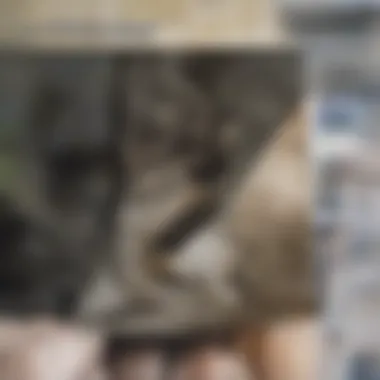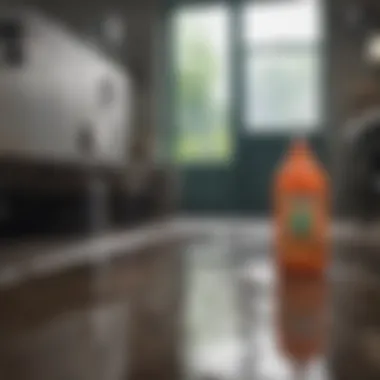Effective Methods for Unclogging Your Drain


Intro
Clogged drains are a common issue for many homeowners. Whether caused by an accumulation of hair, soap scum, or foreign objects, the result is often frustration and inconvenience.
Understanding the methods available for unclogging drains helps individuals tackle these problems effectively. The right approach can save time, money, and even prevent damage to your plumbing.
This article will explore both chemical and natural solutions suitable for various types of drains. It will also delve into the necessary tools, techniques, and steps to address stubborn clogs. Each method's effectiveness will be discussed, enabling homeowners and DIY enthusiasts to make informed decisions about maintaining their plumbing systems.
Understanding the Causes of Clogs
Before diving into solutions, it’s essential to understand what causes drains to clog. Common culprits include:
- Hair: Often found in bathroom drains, hair can quickly accumulate and lead to blockages.
- Grease: Kitchen drains are particularly susceptible to grease buildup from cooking oils and fats.
- Food Debris: Pieces of food thrown down the sink can lead to serious clogs.
- Soap Scum: Soap can combine with minerals in water, creating a sticky residue that builds up over time.
- Foreign Objects: Accidental dropping of items like toys or jewelry can obstruct drainage.
Recognizing these causes allows homeowners to implement preventive measures as well.
Chemical Solutions
Chemical drain cleaning products can be effective but should be used with caution. They often contain harsh substances that can damage pipes over time. Common chemical solutions include:
- Sodium Hydroxide: A strong base that can dissolve organic matter.
- Sodium Bicarbonate and Vinegar: A natural method that combines an acid with a base for a fizzing reaction, which helps dislodge clogs.
- Commercial Drain Cleaners: Look for products specifically designed for your type of drain to avoid damage.
"Using chemical solutions without proper knowledge can lead to pipe damage. Always read the labels carefully."
Natural Solutions
For those seeking safer alternatives, natural solutions can be equally effective. Here are some popular options:
- Baking Soda and Vinegar: Pour a cup of baking soda down the drain, followed by a cup of vinegar. After fizzing, flush with hot water.
- Boiling Water: Slowly pour boiling water down the drain in stages to break up grease.
- Salt: Mixing salt with baking soda can help dislodge clogs when rinsed with hot water.
These methods are usually safe for most plumbing systems and do not pose the same risks as chemical cleaners.
Tools for Unclogging
Certain tools can aid in the unclogging process. Homeowners should consider:
- Plunger: A useful tool for tackling basic clogs by creating suction.
- Drain Snake: This tool can reach deeper clogs and remove debris effectively.
- Hydro Jet: A professional service that uses high-pressure water to clear major blockages, useful for severe issues.
Selecting the proper tool is crucial for effective unclogging.
Ending
Clogged drains are a manageable problem with the right methods and tools. By understanding the causes and applying appropriate solutions, homeowners can maintain their plumbing systems effectively. Whether opting for chemical or natural methods, an informed and careful approach will yield the best results.
Prelims to Drain Clogs
Clogged drains present a common household issue. Addressing this problem swiftly is crucial to maintain hygiene and avoid damage. Clogs can impede water flow, leading to unpleasant odours and even water damage. This section examines the importance of understanding drain clogs and their implications for homeowners.
Understanding Drain System Functionality
First, it is beneficial to comprehend how a drainage system operates. Water flows from taps and appliances into pipes, which transport it away from the house. Each fixture connects to a larger network of pipes, culminating in the main sewer line.
When a clog occurs, the water fails to reach its intended destination. This may happen slowly or rapidly, depending on the severity of the blockage. Knowing how drainage systems function enables one to identify potential issues before they escalate.
Furthermore, familiarity with the system highlights the significance of regular maintenance. Homeowners can avert costly repairs and ensure a healthy living environment by taking preventative measures.


Common Causes of Drain Clogs
Several factors contribute to clogged drains. Recognizing these can help in both prevention and resolution.
- Hair and Soap Scum: In bathrooms, hair combines with soap residues to form stubborn clogs. Over time, these accumulate within the pipes.
- Food Debris: In kitchens, food particles can become trapped in drains, particularly if there is no disposal system in place.
- Grease Build-up: Cooking oils and fats can solidify, creating blockages in kitchen sinks.
- Foreign Objects: Items like toys or hygiene products can exacerbate clogging issues, especially in toilets.
"Understanding the common causes of drain clogs is essential in developing effective unclogging strategies."
By identifying these issues early, homeowners can implement appropriate solutions and avoid more significant complications in the future. This comprehension is beneficial for maintaining clear and efficient drainage throughout the home.
Identifying the Type of Clog
Identifying the type of clog is crucial for effectively resolving drainage issues. Homeowners often encounter clogs unexpectedly, leading to frustration and inconvenience. Understanding the nature of the blockage can save time and prevent mishap. Knowing whether the obstruction is partial or complete directly impacts the approach taken to unblock the drain. Likewise, the location of the clog plays a significant role in developing an appropriate strategy for resolution.
Partial vs. Complete Blockage
A partial blockage allows some water to flow yet remains sufficient enough to hinder normal drainage. This condition may lead to slow draining in sinks, showing early signs of trouble. Monitoring a slow drain can provide the opportunity for intervention before it escalates into a complete blockage. Conversely, a complete blockage halts the flow entirely. It often necessitates immediate action to prevent overflow or damage.
Each type requires a different response. For example, using a plunger is typically more effective for partial blockages. In contrast, complete clogs may need specialized tools such as a drain snake or chemical solutions.
Location of the Clog
The location of the clog is another important consideration while unclogging drains. Identifying where the blockage has occurred can streamline the problem-solving process. Various areas may present unique challenges and necessitate distinct approaches. Below are the four main locations where clogs typically occur:
Kitchen Sink
The kitchen sink is often a hotspot for clogs due to the accumulation of food particles, grease, and soap residue. The key characteristic of this location is the combination of organic and inorganic materials that can form stubborn blockages. Its regular use makes a clogged kitchen sink a frequent headache for homeowners. Those who use a garbage disposal may find that small items can cause issues.
Advantages of addressing kitchen sink clogs include more straightforward access with tools such as plungers or snaking devices. However, persistent problems may indicate underlying plumbing issues that require troubleshooting.
Bathroom Drain
Bathroom drains are another common issue, primarily caused by hair, soap scum, and personal care products. The unique feature of these drains is that they are exposed to various debris regularly. Hair can easily tangle and create significant blockages over time.
The significant advantage here is that many natural methods can be used to address these clogs, such as vinegar and baking soda, which many homeowners prefer. However, repeated blockages might signify an urgent need for more thorough cleaning solutions.
Shower Drain
Shower drains share similar problems with bathroom drains since hair and soap residue can clog them. The key aspect of the shower drain is the design, often leading to hair collecting in the grates or traps. Regular maintenance can mitigate the risk of clogs.
While shower clogs tend to build up over time, they can usually be resolved without professional help. Using a combination of hot water and chemical cleaners can often clear the obstruction effectively.
Toilet
Toilets may present the most challenging clogs due to the variety of materials meant to be flushed. The notable characteristic is the potential for serious damage if the clog is not addressed immediately. Common blockages stem from excess toilet paper or non-flushable items.
When unclogging a toilet, the use of a reliable toilet plunger is often the first line of defense. However, complete blockages may call for a plumbing snake or other specialized tools. Any persistent issue should prompt a call to a plumber to avoid more significant plumbing concerns.
Understanding the type and location of a clog can vastly improve the efficiency of unclogging efforts. Knowledge empowers homeowners to choose the right tools and methods to tackle drains head-on.
Traditional Methods for Unclogging Drains
The traditional methods for unclogging drains hold significant relevance in maintaining a functional plumbing system. These techniques have stood the test of time, providing homeowners with practical solutions for common drainage issues. Relying solely on chemical cleaners can be risky, both for health and the environment. Thus, understanding how to use traditional methods is paramount for anyone looking to resolve clogs effectively without causing further complications.
Plungers: Basic Mechanism
Plungers are one of the oldest and simplest tools used for unclogging drains. Their design consists of a rubber suction cup attached to a wooden or plastic handle. When the plunger's cup is placed over the drain, the downward force creates suction. This suction can dislodge small to moderate blockages, allowing wastewater to flow freely once more.


To effectively use a plunger, ensure the cup fits securely over the drain. Fill the sink or tub with enough water to cover the cup's edge. Then, pump the handle up and down vigorously. This action helps to create pressure. Repeating this a few times can often clear the clog. However, caution is needed. Using a plunger improperly may cause splashing or lead to further blockage.
Drain Snakes: When and How to Use
Drain snakes, or augers, are another key tool for tackling stubborn clogs. This device features a long, flexible metal cable with a coiled end, specifically designed to navigate through pipes. Drain snakes can reach deeper blockages that a plunger cannot dislodge. They are especially useful for clogs in toilets, sinks, and shower drains.
To operate a drain snake, insert the end into the drain opening and push it gently, turning the handle as you go. The coiled end helps grip clogs, enabling it to either break them apart or pull them back out. If resistance is felt, avoid using excessive force, as this can damage the pipes. Clean the snake after use to prevent cross-contamination.
Using plungers and drain snakes offers a cost-effective way to maintain drainage systems. These methods rely on physical force rather than chemicals. This practice reduces environmental impact and mitigates health risks associated with harsh chemicals. Thus, understanding proper techniques to employ these tools is indispensable for any homeowner.
Chemical Solutions
Chemical solutions play a crucial role when it comes to unclogging drains. They offer a quick and often effective means to tackle stubborn blockages in household plumbing. The use of these products can sometimes save time and effort, especially when traditional methods have not produced satisfactory results. However, their application does require careful consideration to ensure safety and effectiveness.
A diverse range of commercial drain cleaners is available. These typically contain powerful substances like sodium hydroxide or acids, designed to dissolve the materials that cause clogs. Understanding their effectiveness is vital, as is being aware of the potential risks involved.
Common Drain Cleaners: Effectiveness and Risks
Common drain cleaners include brands such as Drano, Liquid-Plumr, and Rid-X. Each product operates under different mechanisms, usually targeting organic matter, grease, or hair. Their effectiveness can vary significantly based on the type of clog. For instance, while some cleaners might effectively dissolve fat clogs, they may struggle with mineral deposits.
The use of chemical cleaners is not without risks. Here are several important considerations:
- Toxic Fumes: Many chemical drain cleaners emit harmful vapors that can irritate the respiratory system. It is advisable to use them in well-ventilated areas.
- Pipe Damage: Prolonged use of certain chemicals can corrode pipes, especially older systems made from materials like PVC or galvanized steel.
- Environmental Risks: Improper disposal or spillage of these chemicals can lead to environmental contamination, affecting groundwater sources.
> Therefore, it is critical to read labels and guidelines carefully before choosing a drain cleaner to avoid any unintended consequences.
Environmental Considerations
When selecting a chemical solution for unclogging drains, environmental implications should also be taken into account. The impact of these chemicals extends beyond just the immediate blockages.
- Ingredients: Many drain cleaners contain harsh chemicals that can adversely affect local ecosystems if they enter water systems. Some may persist in the environment, leading to long-term pollution.
- Biodegradability: Some products are worse than others regarding environmental friendliness. Ingredients that do not break down naturally can cause lasting harm to soil and water quality.
- Alternatives: Several eco-friendly drain cleaners exist, which use enzymes or natural acids. These may take longer to work, but they present a safer option both for users and the environment.
By taking into account the environmental impact alongside the effectiveness of chemical solutions, homeowners can make more informed decisions. Choosing the right approach can lead to effective drainage without compromising safety or environmental integrity.
Natural Remedies for Clogs
Natural remedies for unclogging drains are often overlooked but can prove effective and environmentally friendly. Many homeowners seek to avoid harsh chemicals that may pose health hazards or damage plumbing systems. Using simple ingredients commonly found at home, these methods not only target common clogs but also contribute to the overall maintenance of the plumbing system. The benefits of utilizing natural remedies include improved safety, lower costs, and minimized impact on the environment.
Reliable natural solutions can help in tackling minor to moderate clogs without resorting to more aggressive chemical cleaners. By understanding the science behind these remedies, one can appreciate their efficacy while also taking proactive measures to prevent future clogs.
Baking Soda and Vinegar Method
The combination of baking soda and vinegar is a well-known home remedy for clogs. When these two substances come together, a chemical reaction occurs, producing carbon dioxide gas and creating bubbles that can help break apart and dislodge debris.
To use this method, follow these steps:
- Pour half a cup of baking soda down the drain. Baking soda is a mild abrasive that can help scrub away grime.
- Add half a cup of vinegar. The acidity of vinegar will react with the baking soda, creating a fizzing action.
- Cover the drain with a cloth or plug. This helps keep the reaction concentrated in the drain, allowing it to work more effectively.
- Wait for about 30 minutes. During this time, the reaction will help to lift stubborn blockages.
- Flush with hot water. After the waiting period, pour boiling water down the drain to help clear away any remaining debris.
This remedy is not only cost-effective but also safe for your plumbing and the environment. Regular use can also help maintain clear drains.
Salt and Hot Water: A Simple Solution
Another straightforward natural remedy involves using salt combined with hot water. Salt acts as a desiccant that helps to dissolve grease and food particles. This method is particularly useful for kitchen sinks, where grease buildup is common.
Steps for this technique include:


- Boil water. Start with at least three cups of water to ensure enough volume to flush the drain.
- Add half a cup of salt to the boiling water. Stir to dissolve the salt thoroughly.
- Pour the mixture down the drain. Make sure to do this gradually, allowing the mixture to work through the blockage.
- Follow with more hot water. After waiting a few minutes, flush the drain again with more hot water to help clear any remnants.
This method is effective against smaller clogs and can help maintain a smooth flow in the plumbing system over time.
Preventive Measures for Maintaining Clear Drains
Preventive measures are critical when it comes to maintaining clear drains. Taking proactive steps can help avoid the frustration and inconvenience of dealing with clogged drains. The overall health of your plumbing system can be vastly improved, reducing the need for more drastic methods or professional intervention.
Regular maintenance, vigilance, and informed choices can significantly minimize the risk of clogs. By understanding the components of your drainage system and what impacts its functionality, you can make smarter decisions to keep your drains flowing smoothly.
Regular Maintenance Practices
Implementing a routine maintenance schedule is essential for ensuring the clarity of your drains. This could include practices such as:
- Cleaning drain covers: Regularly check and clean the stoppers or covers in sinks and tubs. Hair, soap, and debris can build up quickly, significantly slowing down drainage.
- Flushing with hot water: At least once a week, pour hot water down the drain. This helps dissolve grease and soap residues that might accumulate over time.
- Using a drain strainer: Installing strainers can effectively trap unwanted substances like hair or food particles before they enter the drain, protecting against clogs.
- Regular checks: Inspect your plumbing system for any signs of leaks or slow drainage. Early detection can prevent further complications.
These steps, while simple, promote a healthier wastewater system and help maintain functionality.
What Not to Flush or Pour Down Drains
Certain substances should be avoided to prevent clogging. Familiarizing yourself with harmful materials is a fundamental part of drain care. Key items to refrain from flushing or pouring down drains include:
- Grease and oil: These can solidify as they cool, leading to buildup that hampers flow.
- Coffee grounds: These can clump together and create obstructions.
- Feminine hygiene products: They do not break down easily and can cause significant blockages in plumbing systems.
- Wipes (even if labeled flushable): Most of these do not decompose properly and can lead to severe clogs in sewage systems.
- Cat litter: This material can create large balls that contribute to serious drainage issues.
It’s vital to educate all members of the household about responsible flushing and pouring practices. This knowledge can prevent the bulk of common drainage issues before they arise.
By adhering to proper maintenance habits and being mindful of what goes down the drain, homeowners can create a smoother and more efficient drainage experience, ultimately saving time and money.
When to Call a Professional
Dealing with drain clogs can be a frustrating experience. While many homeowners attempt to resolve these issues using various methods, there are specific situations where calling a professional becomes necessary. Understanding these conditions optimizes your time and ensures that the problem is properly addressed. This section will delve into the signs indicating that professional help is needed, as well as the process of choosing the right plumber.
Signs Indicating Professional Help is Needed
There are several critical signs that suggest it may be time to seek the expertise of a plumbing professional. These signs indicate that the issue may be more complex than a simple clog. Here are some key indicators:
- Persistent Clogs: If you repeatedly experience clogs in the same drain, it suggests that there may be a deeper issue at play. In such cases, a plumber can perform a thorough inspection.
- Multiple Fixture Issues: When more than one fixture in your home, such as sinks, toilets, or bathtubs, are exhibiting problems, this could point to a mainline backup or another significant blockage in the system.
- Unpleasant Odors: A foul smell emanating from your drains might indicate trapped waste or a buildup of material somewhere in the pipes. This situation often requires specialized tools that a professional has.
- Slow Drainage: If your drains are slow even after attempting home remedies, it can signify that there are serious obstructions. Addressing slow drainage early can prevent further complications.
- Water Backups: Water backing up from the toilet or sink is a clear signal of a blockage that requires professional intervention.
- Unusual Sounds: Gurgling sounds from drains may suggest that air is being pushed through an obstruction. This phenomenon should not be ignored.
"Ignoring drain issues can lead to costlier repairs down the line. A professional can offer solutions before it gets worse."
Choosing the Right Plumber
Selecting a qualified plumber is crucial for ensuring the successful resolution of your drain issues. The following tips can help guide the selection process:
- Seek Recommendations: Start by asking neighbors, friends, or family for references. Personal experiences can often lead you to reliable professionals.
- Research Credentials: Ensure the plumber is licensed and insured, which indicates they meet industry standards and are qualified to perform the work.
- Read Reviews: Online platforms, such as Yelp or local business directories, can provide insights into the experiences of past clients. Look for feedback on their reliability and quality of work.
- Get Multiple Estimates: Contact a few plumbers to request estimates on the work needed. This can help you compare prices and scope of services offered.
- Ask About Experience: Inquire about the plumber's experience with similar drain issues. A knowledgeable professional will often provide better solutions.
- Evaluate Communication: A good plumber should be easy to communicate with, answering your questions clearly and promptly. This trait reflects their customer service approach.
By being attentive to the signs requiring professional aid and carefully selecting a plumber, you can effectively navigate the complexities associated with drain problems.
Epilogue
In the journey of mastering drain maintenance, we arrive at the conclusive thoughts surrounding the essential methods for unclogging drains. This article has explored a variety of techniques, emphasizing both traditional and innovative approaches. Understanding the processes involved is crucial for homeowners and enthusiasts alike.
The importance of incorporating effective methods for unclogging drains cannot be overstated. Clogs disrupt daily routines, causing inconvenience and potential damage. With the right knowledge, many blockages can be resolved at home without needing costly professional assistance.
Key elements discussed include:
- Understanding common causes of clogs: Awareness allows for proactive measures, mitigating potential issues before they escalate.
- Chemical and natural solutions: Knowing which products to use—and which to avoid—empowers you to make environmentally conscious choices while addressing blockages.
- Maintenance practices: Regular upkeep is fundamental. Engaging in preventive measures not only keeps drains flowing but also extends the lifespan of plumbing systems.
While many drain issues can be self-managed, it is essential to recognize when to seek professional help. This discernment can save resources in the long term.
In summary, this article has provided readers with vital tools to tackle drain clogs efficiently. Adopting these methods contributes to maintaining a healthy home environment and enhancing overall well-being.
"An ounce of prevention is worth a pound of cure"—this well-known sentiment rings true in the context of drain maintenance.







